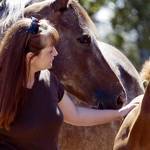Follicle Development and Ovulation in Mares

An ovarian follicle is a fluid-filled sac surrounded by a group of cells that protect and nourish the ovum (egg). There are thousands of follicles in a mare’s ovaries, but usually only one begins to develop during each estrous cycle. By the sixteenth day of the cycle, the developing follicle has reached the size at which it secretes enough hormone to bring on the external characteristics of heat. Around day 20, the follicle reaches its full size and ruptures, releasing the egg into the fallopian tube (ovulation). The ruptured follicle forms the corpus luteum (CL), which secretes the hormones that prepare the uterus for pregnancy.
After ovulation, the egg survives in the fallopian tube where it survives for up to 12 hours and must be fertilized by a sperm within that time if pregnancy is to be achieved. Ideally, the mare is bred a few hours before ovulation so that the sperm will be already in the fallopian tube when the egg is released. The trick to effective breeding is knowing precisely when a mare is ready to ovulate: 50% of mares ovulate 24 hours before the end of heat, 30% ovulate 48 hours before the end of heat, some mares may come into heat but do not ovulate, and others ovulate without showing obvious signs of heat.
Mares can be examined by a veterinarian, who will feel the size of the follicle by palpation from the rectum or with ultrasound and then advise the stud manager on the best time to have the mare served.








